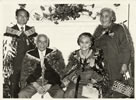Catholics and Labour Party
Catholics were strongly represented in the early Labour Party, which shared their dislike for the Protestant Political Association and supported Irish self-determination. In 1922 Bishop Liston publicly rejoiced at Labour's electoral gains: ‘Thanks be to God, the Labour people, our friends, are coming into their own – a fair share in the Government of the country.’1 In 1935 the Labour Party, led by a Catholic, Michael Joseph Savage, swept to power and the New Zealand Catholic Church regained confidence and national pride.
New Zealand-born Bishops
Also in 1935 Francis Redwood, the last link with the Church's Marist pioneers, died. Like the country itself, the Catholic Church was turning to the native-born for leadership, beginning with James Liston (Bishop of Auckland 1929–70) and Matthew Brodie (Bishop of Christchurch 1916–43). These new leaders insisted that Catholics were no strangers in the land of their birth. Liston's confidence that Labour (and his non-Catholic countrymen) would treat Catholics fairly was soon rewarded. Church schools were given a number of minor concessions. The sense that the era of exclusion was over was reinforced by enthusiastic Catholic participation in the Second World War and the Korean War.
Māori Catholics
One of the most prominent Māori Catholics in the 1950s and 1960s was Whina Cooper (Te Rarawa), from the Hokianga. She moved her family to Auckland in the early 1950s and was horrified to see the conditions in which some of her people were living. She set up an Auckland Catholic Māori Society, which raised funds to build an urban Catholic marae, Te Unga Waka, in Epsom. Her nephew, Father Henare Tate, became the second Māori to be ordained as a priest.
Catholic communities after the Second World War
In the 1950s and 1960s New Zealand Catholics generally formed close-knit communities, friendly with non-Catholics but seldom marrying them. Catholics in that period ate fish rather than meat on Fridays. Their children went to different schools than non-Catholics and their sports teams were organised into different clubs, such as the Marist rugby clubs. Rivalry with non-Catholic teams spurred fierce competition on rugby fields and basketball (netball) courts.
A nationwide network of Hibernian Societies (Catholic welfare societies, named after the ancient name for Ireland), helped those in need. St Patrick’s Day was an occasion for noisy and joyful parties, with traditional Irish songs and dancing. The heart of Catholic communities were the local churches where Mass was said in sonorous Latin.
Changing the church
The process of healing old ethnic and religious wounds was greatly accelerated by the reforms of the Second Vatican Council in 1962–65. From 1970 Mass in New Zealand was said in either English or Māori. New hymns and prayers with more relevance to local seasons and ideas were introduced. The reforms also led to church services with other Christian religions, joint Good Friday processions, and joint social justice projects. Many Catholics took up justice and peace causes in their own communities, as well as nationally and internationally. During the Springbok tour of 1981 Catholics were deeply involved in the movement against apartheid.
State funding for church schools
The new liberal climate encouraged joint action by some Christian churches to secure state funding for church schools, which were suffering due to post-war population pressure and rising educational standards. The third Labour government passed the Private Schools Conditional Integration Act 1975, which allowed religious schools to join the state education system on terms that protected their special character.
By 1983 all 249 Catholic primary and secondary schools had become ‘state integrated schools’, saving many of them from financial collapse. The act marked the full integration of Catholics into New Zealand life. This was demonstrated in 1986 when Pope John Paul II became the first pope to visit New Zealand.




